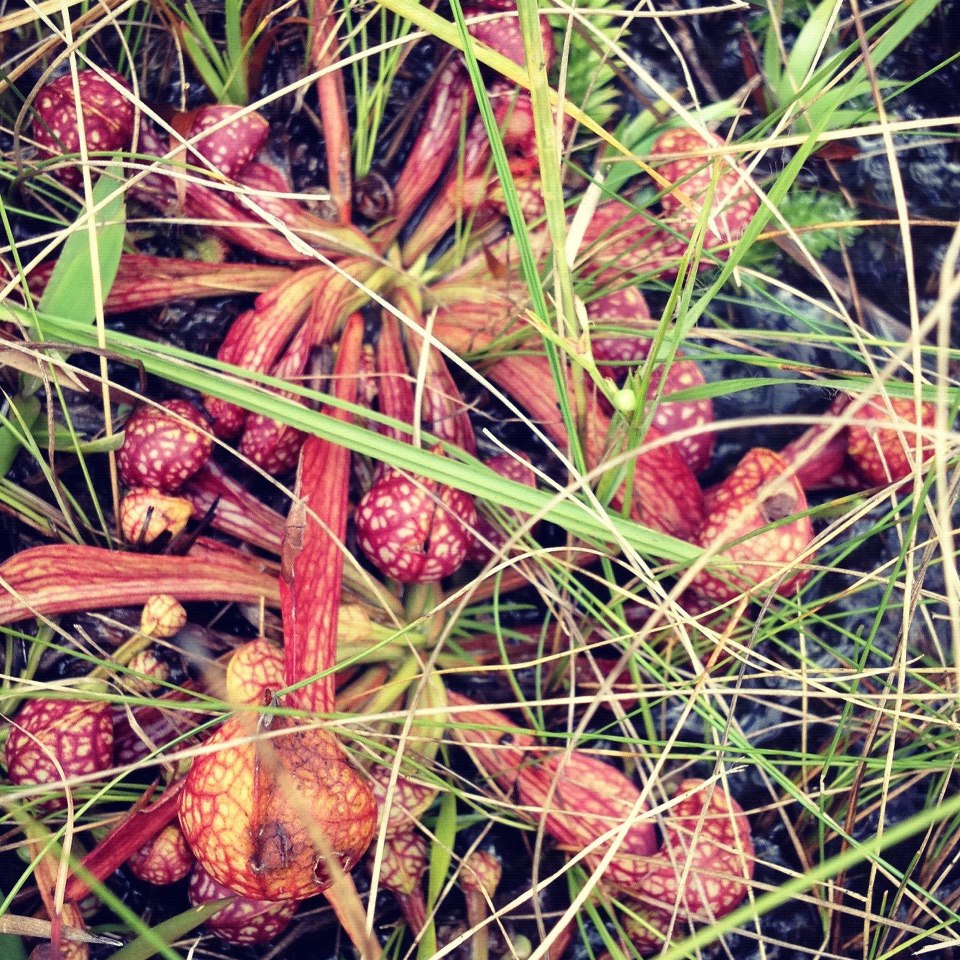
by Carrie Stevenson | Mar 29, 2016
Among the most fascinating natural phenomena in our area are the presence of dozens of species of carnivorous, or meat-eating, plants. Found in bogs, meadows, and seepage slopes with mucky, acidic soils and low levels of nutrients, these plants have adapted to their difficult conditions by developing ways to digest insects.These carnivores are best known by their common names; sundew, butterwort, bladderwort, and pitcher plants.
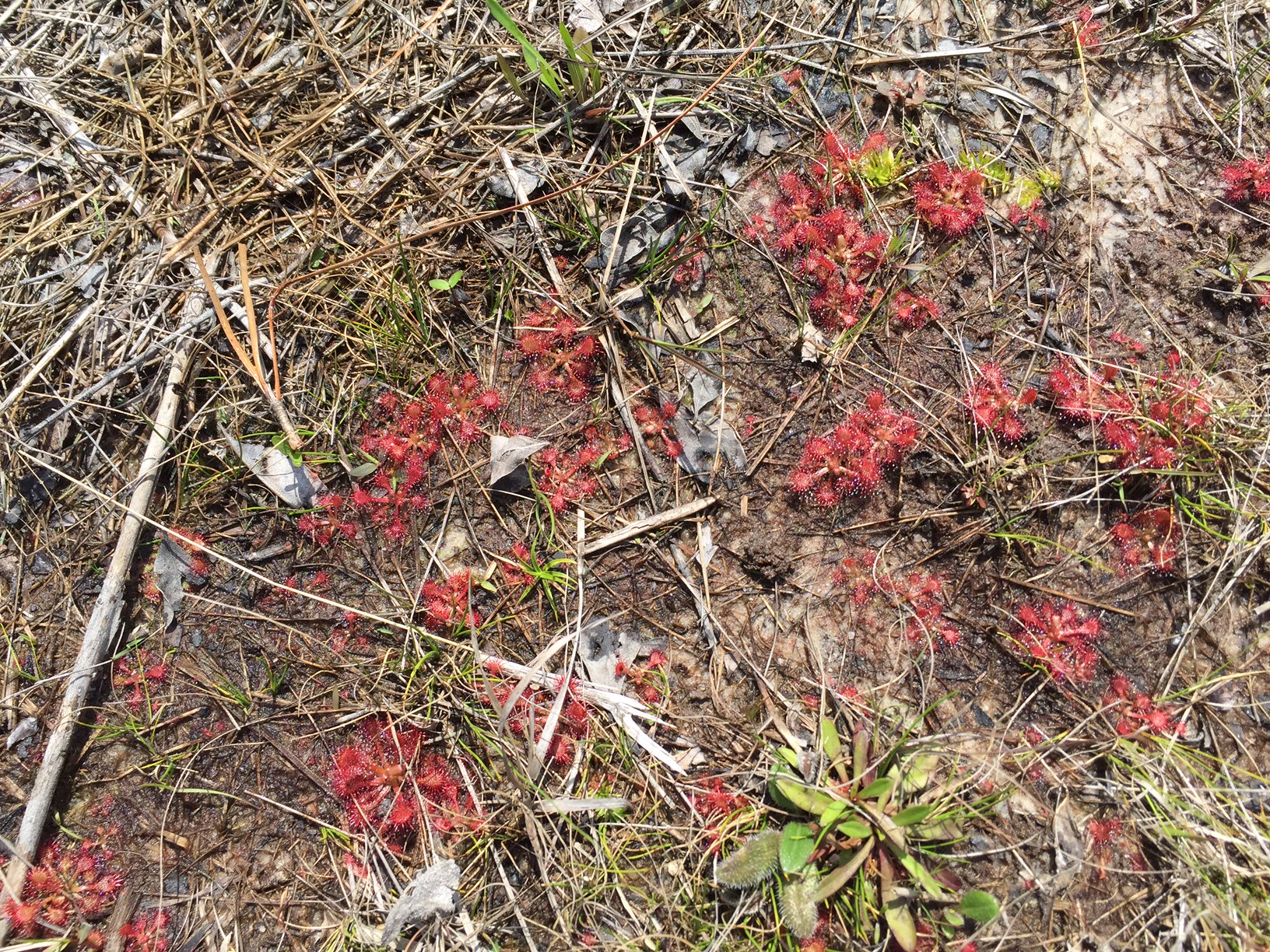
Sundew plants ready to feast
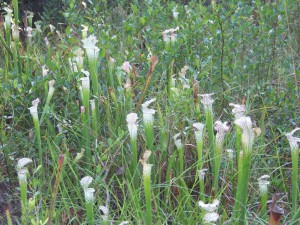
A meadow of white-topped pitcher plants in full spring bloom.
While there are six species of pitcher plants found in the panhandle and throughout the Gulf Coastal Plain, the “world’s largest concentration” can be found at Escambia County’s Tarkiln Bayou Preserve State Park. The “pitcher” part of the plant is actually a modified leaf, which is rounded into a hollow tube open at the top and partially covered by a hood. This hood is colorfully patterned, attracting insects also drawn to nectar inside the tubes. As insects crawl in, downward-facing hairs prevent them from escaping. They drown in the collected water within the tubes, then decompose via acids and enyzymes secreted by the plant into a “liquid fertilizer.” A handful of commensal animals, including flies, spiders, and small frogs, take advantage of the pitcher plants’ insect-trapping expertise and manage to avoid capture.
A guide to identifying all six of these pitcher plant species–white-top, parrot, trumpet-leaf, hooded, sweet, and yellow–can be found at the Florida Department of Environmental Protection’s wetland plant site. Now is the perfect time to see pitcher plants beginning to blossom.
While many people are familiar with pitcher plants, fewer notice the low-growing sundew. These plants may be smaller than a dime in circumference, and grow flat along very mucky soil in full sun. If shaded out even by relatively short grasses, sundew disappear. Their characteristic pinwheel-like appearance and deep red coloring help draw the eye if you look very closely. Sundews also excrete a sticky nectar, on which small insects get stuck and digested to provide nutrients to the plants.The leaves of butterwort plants work very similarly to sundews; they are typically bright green and succulent with sticky hairs that attract nutrients.
Bladderworts, also found in similar environments, use a different mechanism to trap insects. They actually have a bladder-like formation within their root system that opens and closes, siphoning water and unlucky insects in and out.
Regardless of their location, appearance, or method of trapping, carnivorous plants remain one of the most unusual, and interesting groups within the plant kingdom. Be sure to take the opportunity this spring to seek out a park or natural area populated with carnivorous plants–such as Tarkiln, Blackwater River State Park, or the public areas of Eglin Air Force Base and see them for yourself!
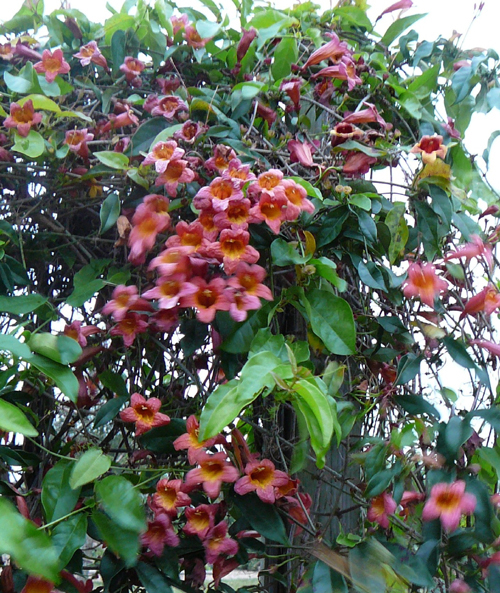
by Sheila Dunning | Mar 22, 2016
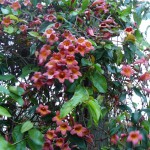 According to the Atlas of Florida Vascular Plants, there are more than 4,200 plant species naturally occurring in the state. Nearly 3,000 are considered native. The Florida Native Plant Society (FNPS) defines native plants as “those species occurring within the state boundaries prior to European contact, according to the best available scientific and historical documentation.” In other words, the plants that grew in natural habitats that existed prior to development.
According to the Atlas of Florida Vascular Plants, there are more than 4,200 plant species naturally occurring in the state. Nearly 3,000 are considered native. The Florida Native Plant Society (FNPS) defines native plants as “those species occurring within the state boundaries prior to European contact, according to the best available scientific and historical documentation.” In other words, the plants that grew in natural habitats that existed prior to development.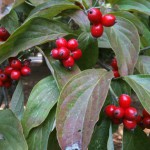
Native plants evolved in their own ecological niches. They are suited to the local climate and can survive without fertilization, irrigation or cold protection. Because a single native plant species usually does not dominate an area, there is biodiversity. Native plants and wildlife evolved together in communities, so they complement each other’s needs. Florida ranks 7th among all 50 states in biodiversity for number of species of vertebrates and plants. Deer browse on native vines like Crossvine (Bignonia capreolata), Trumpet Creeper (Campsis 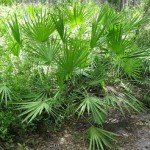 radicans), Yellow Jessamine (Gelsemium sempervirens) and Trumpet Honeysuckle (Lonicera sempervirens). The seeds and berries of Black-eyed Susan (Rudbeckia fulgida), Flowering Dogwood (Cornus florida) and Dahoon holly (Ilex cassine) provide vital food for songbirds, both local and migratory. Saw palmetto (Serenoa repens) provides cover for numerous birds and small mammals, as well as, reptiles.
radicans), Yellow Jessamine (Gelsemium sempervirens) and Trumpet Honeysuckle (Lonicera sempervirens). The seeds and berries of Black-eyed Susan (Rudbeckia fulgida), Flowering Dogwood (Cornus florida) and Dahoon holly (Ilex cassine) provide vital food for songbirds, both local and migratory. Saw palmetto (Serenoa repens) provides cover for numerous birds and small mammals, as well as, reptiles.
Non-native plants become “naturalized” if they establish self-sustaining populations. Nearly one-third of the plants currently growing wild in Florida are not native. 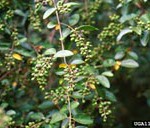 While these plant species from other parts of the world may provide some of the resources needed by native wildlife, it comes at a cost to the habitat. These exotic plants can become “invasive”, meaning they displace native plants and change the diverse population into a monoculture of one species. Chinese privet (Ligustrum sinense), Popcorn trees (Triadica sebifera) and Cogongrass (Imperata cylindrica) have
While these plant species from other parts of the world may provide some of the resources needed by native wildlife, it comes at a cost to the habitat. These exotic plants can become “invasive”, meaning they displace native plants and change the diverse population into a monoculture of one species. Chinese privet (Ligustrum sinense), Popcorn trees (Triadica sebifera) and Cogongrass (Imperata cylindrica) have 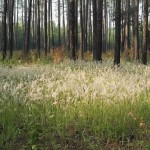 changed the landscape of Florida over the past decade. While Water hyacinth (Eichhornia crassipes) and Hydrilla (Hydrilla verticillata) have change water flow in many rivers and lakes. These invasive species cost millions of taxpayer dollars to control.
changed the landscape of Florida over the past decade. While Water hyacinth (Eichhornia crassipes) and Hydrilla (Hydrilla verticillata) have change water flow in many rivers and lakes. These invasive species cost millions of taxpayer dollars to control.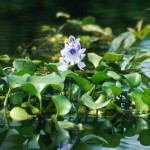
By choosing to use native plants and removing non-native invasive plants, individuals can reduce the disruptions to natural areas, improve wildlife habitat and maintain Florida’s biodiversity.
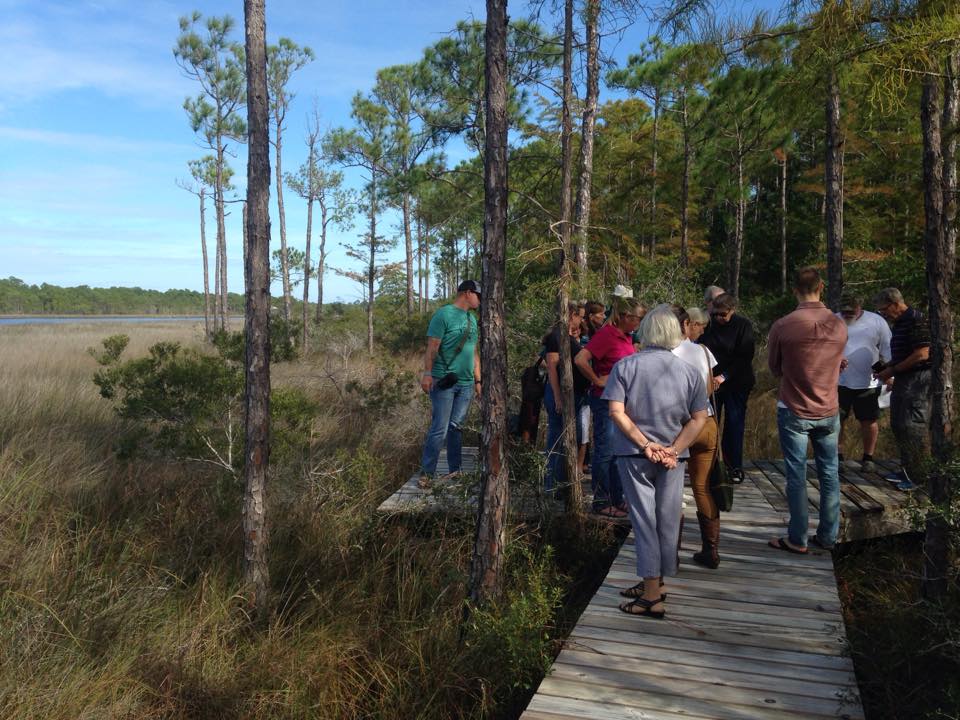
by Carrie Stevenson | Feb 3, 2016
Do you love the outdoors? Wish you knew more about the plants and animals native to our area?
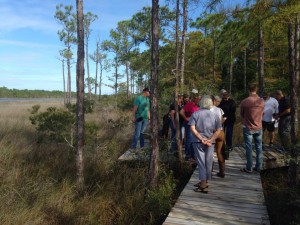
Master Naturalist Jerry Patee leads classmates along his project: a wetland boardwalk in Perdido Key. Photo credit: Carrie Stevenson
The Florida Master Naturalist Program is a course offered by Extension agents throughout the state, including the northwestern counties. Three different modules—Freshwater Wetlands, Coastal, and Uplands—are offered. They include 40 hours of instruction time on ecosystems, plant identification, animal ecology, and how humans live within the environment. Each class includes 2-3 field trips which may entail hikes, paddling, or tours of local museums and parks. Adult students are expected to produce an educational project at the end of the course, which may vary from a display or presentation to a skit or full-blown nature trail.
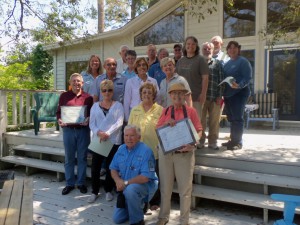
Proud Master Naturalist students at their graduation. Photo credit: Carrie Stevenson
Several Master Naturalists have recently brought their projects to life. Several years ago, Charlie Lurton created a plan to build living shorelines in Bayou Grande behind homes in his neighborhood. The project was approved by state and federal environmental regulatory agencies and oyster reefs and planting have recently begun. Jerry Patee, also an Escambia County Master Gardener, worked with his church to create a boardwalk trail through wetlands to a pristine view of Bayou Garcon in Perdido Key.
Master Naturalist students vary in backgrounds from retired military and teachers to new residents and college students. Many Master Gardeners find the courses a helpful addition to their training, and utilize their newly gained knowledge when working with clientele. At completion, students receive an official Florida Master Naturalist certificate, pin, and patch. Several Panhandle courses will be offered this spring—check out the FMNP website to see when a class will be offered near you!
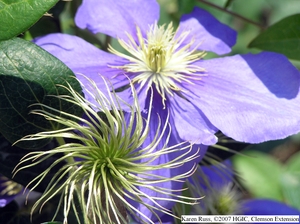
by Matt Lollar | Dec 16, 2015
With the cotton harvest coming to an end, it’s not unusual to see cotton littered on the sides of the road. You may also think you see it hanging in the trees, but you will be pleasantly surprised to find a hidden gem. Woodbine (Clematis virginiana) and coastal virgin’s bower (Clematis catesbyana) are two native species of clematis that can be found wrapped around trees in the Panhandle. They have finished flowering for the year and you will notice their showy seed lint hanging in the trees.
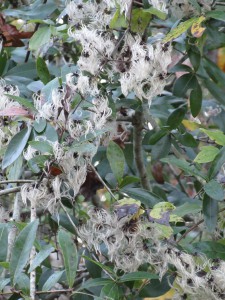
Clematis growing in an oak tree. Photo Credit: Matt Lollar, UF/IFAS
Clematis leaves are compound, consisting of 3 to 5 leaflets, dark green and glossy with toothed edges. The vines are typically 1/2 inch in diameter and can grow to 20 feet. The flowers are much smaller than those of cultivated varieties found at garden centers. Flowers are white with prominent stamens. Clematis catesbyana and Clematis virginiana have similar flowers, but the flowers of C. virginiana are fragrant.
Clematis species grow well in partial shade to full shade. Native plants are often found entwined in the forest understory near streams or ponds where soil conditions are moist. Garden varieties grow well with their roots in moist, shaded soil and their leaves and flowers in the sun. They are often seen growing on a trellis or on a fence.
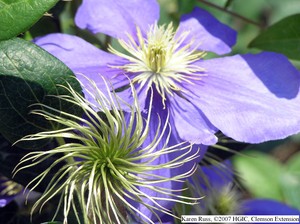
Clematis ‘General Sikorski’. Photo Credit: Karen Russ, Clemson University
It is important to note that some species of clematis are invasive. Sweet autumn clematis or Japanese clematis (Clematis terniflora) is a vigorous invasive species that was once popular in southern gardens. This species has similar characteristics to C. catesbyana and C. virginiana, but its leaflets have smooth edges. You should develop a control strategy if Japanese clematis is found in your garden. For control options, please visit EDIS – Japanese Clematis.
by Mary Salinas | Dec 4, 2015
The cooler weather in the wintertime makes it a great time to plant trees and shrubs. That is why Arbor Day in Florida is the third Friday in January. In 2016, that event is January 15.

Baldcypress growing at the edge of a pond. Photo: Julie McConnell, UF/IFAS
Start your planning now with doing a site assessment on your landscape, then choosing the right trees and shrubs for your particular environmental conditions.
Here are some great sites that offer online tools for finding just the right species:
Florida Tree Selector
The Florida-friendly Guide to Plant Selection & Landscape Design
Florida Native Plant Society Locator
And if you want to find out just how much your established trees are worth, use this National Tree Benefit Calculator!
For more information:
Planting Trees in the Landscape
Arbor Day Foundation: Florida

by Matt Lollar | Nov 18, 2015
Yaupon hollies (Ilex vomitoria) are evergreen, provide great fall/winter color, and can adapt to numerous landscape situations. They are also very durable and can survive extreme drought.
Characteristics
Yaupon hollies are dioecious, meaning male and female flowers are produced on separate plants and berries are only produced on female plants. Flowers are creamy white, but not showy on both male and female plants and berries can range in color from red to yellow depending on cultivar. The plants are favored by wildlife – pollinators are attracted to the flowers and birds love the berries.
Yaupon hollies are native plants with a number of different cultivars available at plant nurseries. ‘Jewel’ is a cultivar that produces an ubundance of red berries and ‘Aureo’ produces yellow berries. ‘Nana’, a dwarf, compact male cultivar is an excellent replacement for boxwoods. Large growing cultivars can grow to 15 to 25 feet tall and can be shaped as trees or left as large shrubs. ‘Folsom’s Weeping’ and ‘Pendula’ are two weeping cultivars that can be utilized as dramatic specimen trees.

Dwarf Yaupon hollies will naturally form a mound without pruning.
Credit: Beth Bolles, UF IFAS Extension Escambia County

Yaupon holly fruit and foliage. Photo courtesy UF/IFAS.
Plant Care
Yaupon hollies prefer to be planted in full to partial sun. It is important to note that they are drought tolerant and require a site with well-drained soil. Because only the female plants produce berries, it is best to purchase plant material when plants contain berries in late fall and winter. Yaupon hollies spread readily by vegetative sprouts. Sprouts should be pruned down to the soil line 2 – 3 times per year. They do not have many disease or insect problems, but scale, leaf miners, mites, and aphids can sometimes be a problem.
Fun Facts
The leaves of the yaupon holly contain a higher caffeine content than any other plant native to North America. The Seminole Indians would purposely brew a concentrated “Black Drink” tea to induce vomiting and diarrhea for believed purification. Southerners utilized the caffeine in the leaves during the Civil War. If the leaves are steeped for a short period, a black tea or coffee substitute can brewed. A related species of holly (Ilex paraguariensis) from Brazil is used to make a drink called Yerba Mate, which is as popular in South America as coffee is in North America.
For more information on yaupon hollies, please visit the publication located at this link https://edis.ifas.ufl.edu/st311.




















